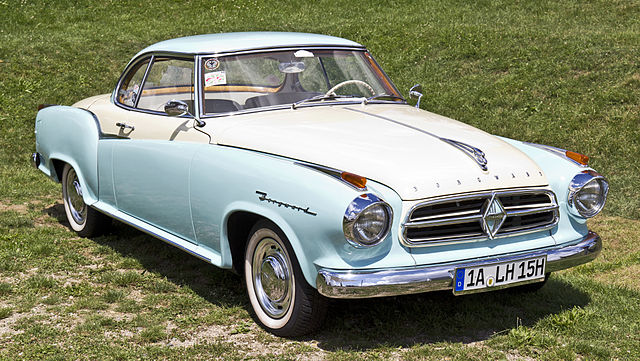Borgward was an automotive manufacturer founded by Carl F. Borgward in Bremen in 1929 which, for several reasons, was finally wound up in 1961. Whilst Borgward was highly creative he was also rather idiosyncratic and didn't delegate well with the company spreading itself too thin, having launched development programmes for more than thirty vehicles over the years and offering fourteen different types of car in the years before they shut down the high development costs spread over lower production runs caused liquidity problems. When an economic downturn hit they were especially vulnerable forcing them to them to take out an overdraft for 30 million Deutsche Marks that was guaranteed by the Bremen state government. Things appeared to have steadied when a highly critical newspaper article in Der Spiegel appeared followed by others in different publications, indirectly this led the banks to withhold the third tranche of ten million Deutsche Marks after the first two and the Chairman, a political appointee by the Bremen government Borgward had been forced to accept, to join with other board members to put the company into administration. Borgward had to give up ownership of the company and walk away, all the while insisting that the company was still solvent, and the government liquidated it to pay off the creditors. The fact that all the creditors were paid off in full with a small amount left over created a debate over whether it was merely messy accounting and liquidity problems that caused an unnecessary closure or if it was a conspiracy on the part of certain powerful interests to slim down the number of car manufacturers in Germany and the local shipyards not wanting to have to compete for skilled workers.
Anyway, to the question at hand. What do people think might of happened if BMC had decided to step in and buy the company? They promptly send some people across to look at the books, decide if isn't a complete disaster, and offer to buy Borgward out personally for say a million Deutsche Marks and to then pay off the twenty million Deutsche Marks of loans? That would be roughly nineteen million pounds at the time. An expansion into Europe isn't that out of the blue since they were already considering it in our timeline starting construction of a plant at Seneffe in Belgium in 1962. Although Seneffe had a number of benefits such as location and transport links purchasing Borgward would provide a number of interesting automotive technologies, an established brand and models which could be kept in slimmed down numbers alongside BMC vehicles, turn-key facilities with equipment and an already trained workforce. The UK wasn't yet a member of the EEC, their application would be made later in the year and even then take a couple of years to deal with whilst not looking anything like a guaranteed result, so a plant on the continent would be a useful hedge against rejection allowing them to bypass the EEC's tariff walls opening up new markets. This article argues that it was being on the outside of the EEC, alongside decisions that they made themselves it has to be remembered, that helped cause BMC's failure. An unforeseen benefit could also be in the 1970s where if there was spare capacity then after Britain joins the EEC in 1973 they might be able to export cars back to the UK to help mitigate shortages from strikes as Ford did IIRC.
Anyway, to the question at hand. What do people think might of happened if BMC had decided to step in and buy the company? They promptly send some people across to look at the books, decide if isn't a complete disaster, and offer to buy Borgward out personally for say a million Deutsche Marks and to then pay off the twenty million Deutsche Marks of loans? That would be roughly nineteen million pounds at the time. An expansion into Europe isn't that out of the blue since they were already considering it in our timeline starting construction of a plant at Seneffe in Belgium in 1962. Although Seneffe had a number of benefits such as location and transport links purchasing Borgward would provide a number of interesting automotive technologies, an established brand and models which could be kept in slimmed down numbers alongside BMC vehicles, turn-key facilities with equipment and an already trained workforce. The UK wasn't yet a member of the EEC, their application would be made later in the year and even then take a couple of years to deal with whilst not looking anything like a guaranteed result, so a plant on the continent would be a useful hedge against rejection allowing them to bypass the EEC's tariff walls opening up new markets. This article argues that it was being on the outside of the EEC, alongside decisions that they made themselves it has to be remembered, that helped cause BMC's failure. An unforeseen benefit could also be in the 1970s where if there was spare capacity then after Britain joins the EEC in 1973 they might be able to export cars back to the UK to help mitigate shortages from strikes as Ford did IIRC.




